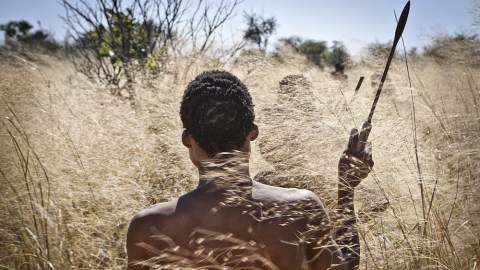Should Olympic Athletes Train Like Our Paleo Ancestors?

This post originally appeared on RealClearScience’s Newton blog. You can read the original here.
Stuart Farquhar stepped onto the track, claps and cheers ringing in his ears. The night air was crisp and cool. Bright lights, and a stadium packed with people filled his peripheral vision, but he sternly zeroed in on the runway ahead. Holding his 800-gram javelin aloft just above his right ear, Farquhar began to sprint. Near the end of the short, 30-meter runway, he initiated his throwing motion. Extending his right arm straight back and cocking his upper body like a taught bow, Farquhar built up an immense amount of potential energy in a mere second. In the next second, he unleashed it all, hurling the javelin into the night with a barbaric yawp…
…The spear struck its target: in the midsection, just behind the boar’s front-right leg. The animal sprinted off, but the hunter knew that it would not go far. Keenly tracking the pig’s path through the dense brush, the hunter found the boar prostrate, rattling off its final breaths. Tonight, there would be food for all.
Many Olympic sports closely parallel the activities of our Paleolithic ancestors: javelin throwing and endurance running, for example. It’s a similarity that might cause one to wonder, should athletes train like our ancestors as well?
In a new paper published in Sports Medicine, Professor Daniel Boullosa of the Catholic University of Brazil posits exactly that.
“Our ancestors lived as hunter-gatherers for approximately 84,000 generations. An appealing hypothesis could be that activities that favored survival before and during the Paleolithic Era may evoke greater physiological adaptations and subsequent performance than other training stimuli.”
Olympic athletes train their bodies as befits their chosen sport. The regimes are honed to such a degree that it would make the average person’s head spin. Sprinters, for example, mix bouts of sprinting, lower-intensity exercise, and maximal strength weightlifting at precise times in order to extract peak physiological performance from their bodies when the starting gun fires. Tiny tweaks can mean fractions of a second, which in turn can translate to being on the medal podium or off.
Boullosa says that these regimes should be kept relatively unchanged, but can still be augmented with Paleolithic improvements. For example, since our ancestors supposedly would rest on days after big hunts, where as many as 8,000 calories might be expended, athletes should be sure to rest after huge training days. In addition, our ancestors were regularly active at all times, so Boullosa also suggests that all athletes could see physiological improvements simply by increasing their daily light physical activity.
“This is very easy to see in elite endurance training but other athletes could incorporate long walks or any physical activity in their leisure time and avoid sedentary activities,” he told RCScience.
Previous studies support this conclusion. One found that men who engaged in more light activities while undertaking an endurance training program saw a larger increase in aerobic capacity than those who did not.
While Boullosa argues that athletes may benefit from adopting some aspects of the Paleolithic lifestyle in their training regimen, he says the data doesn’t altogether support consuming a “Paleolithic diet,” characterized by lower carbohydrate intake along with higher fat and protein consumption. Since muscles prefer to run on stored carbohydrates in the form of glycogen, high intensity sports necessitate adequate carbohydrate intake for optimal performance, he says. However, Boullosa acknowledges that some studies have shown that consuming fewer carbohydrates during training may enhance training adaptations, though much more evidence is needed.
Overall, Boullosa’s theory makes some intuitive sense, but it will need to be adapted to a training regimen with precise recommendations and exercise prescriptions so that it can be scrutinized rigorously and properly in future studies.
Source: Boullosa DA, Abreu L, Varela-Sanz A, Mujika I. Do Olympic Athletes Train as in the Paleolithic Era? Sports Medicine 2013 Aug 20.
(Image: Bushman Hunting via Shutterstock)





